Answered step by step
Verified Expert Solution
Question
1 Approved Answer
My main hope is to get subnetting challenge #3 answered, thank you! 1.3.3 Subnetting Challenge #2: In the previous page, you identified the outward facing
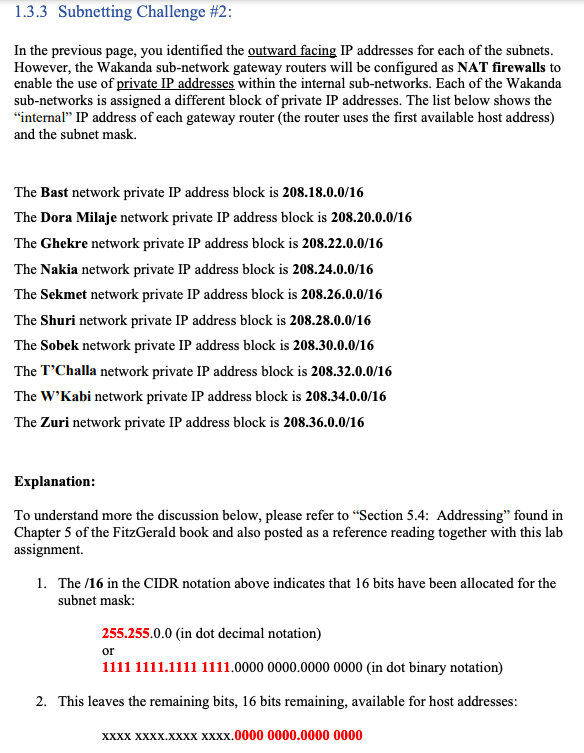
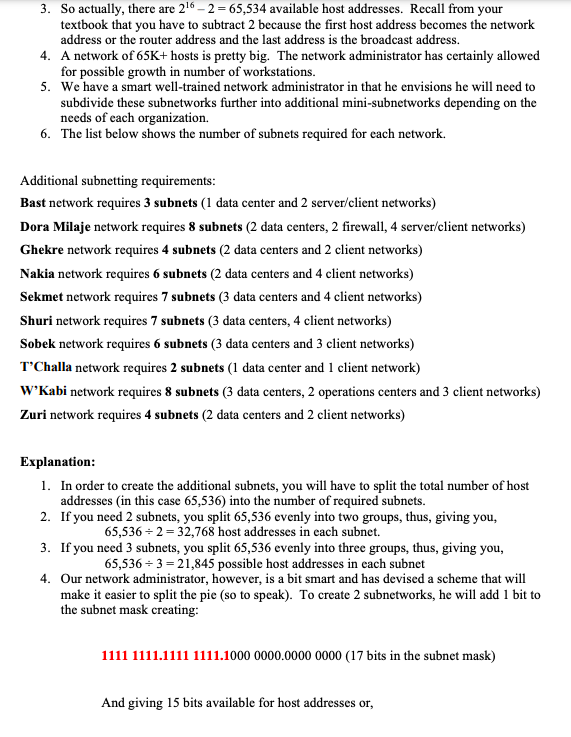
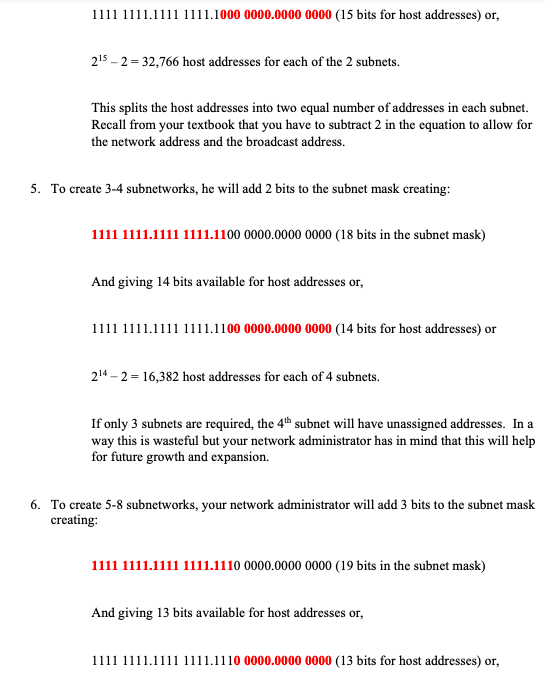

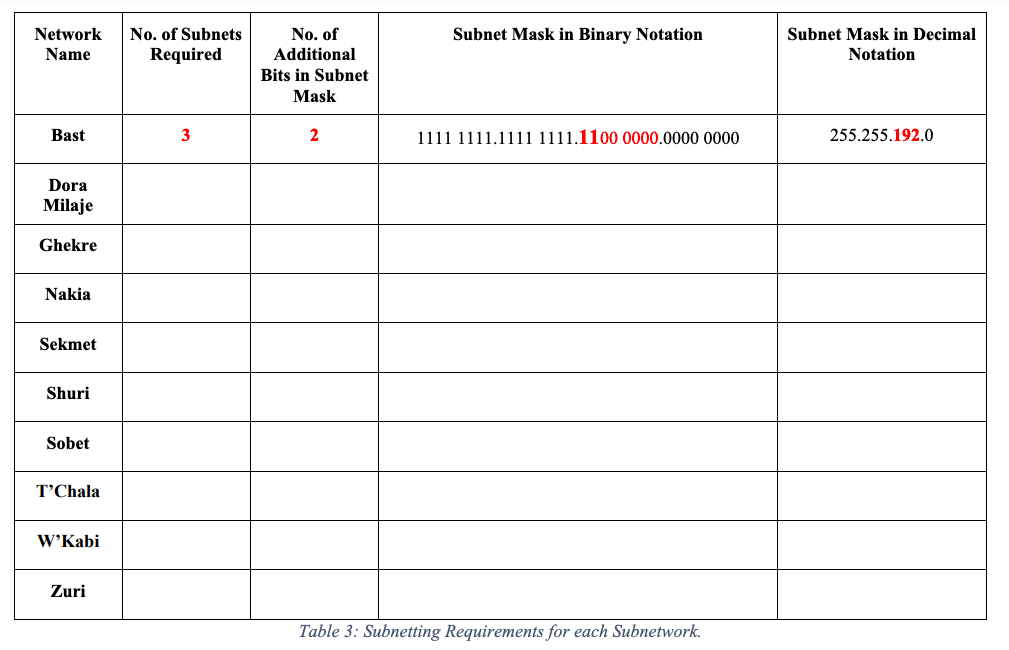
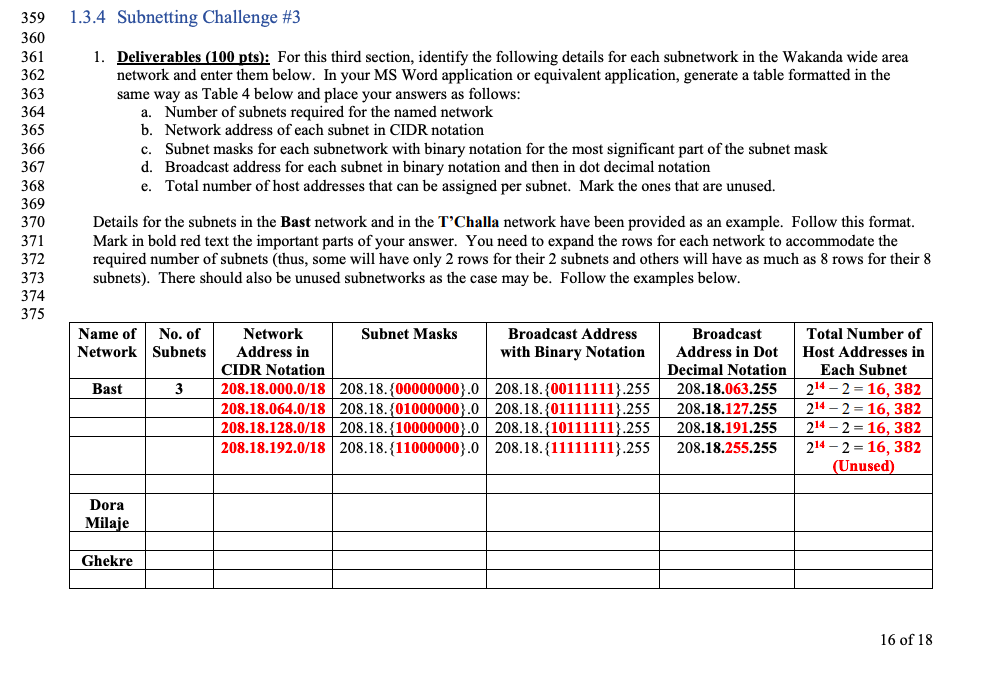
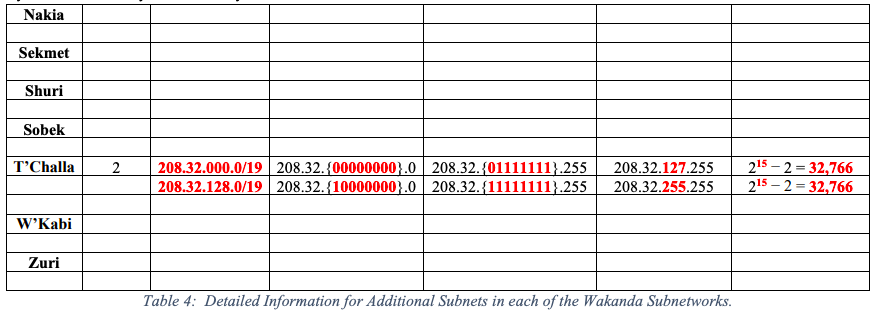
My main hope is to get subnetting challenge #3 answered, thank you!
1.3.3 Subnetting Challenge #2: In the previous page, you identified the outward facing IP addresses for each of the subnets. However, the Wakanda sub-network gateway routers will be configured as NAT firewalls to enable the use of private IP addresses within the internal sub-networks. Each of the Wakanda sub-networks is assigned a different block of private IP addresses. The list below shows the "internal IP address of each gateway router (the router uses the first available host address) and the subnet mask. The Bast network private IP address block is 208.18.0.0/16 The Dora Milaje network private IP address block is 208.20.0.0/16 The Ghekre network private IP address block is 208.22.0.0/16 The Nakia network private IP address block is 208.24.0.0/16 The Sekmet network private IP address block is 208.26.0.0/16 The Shuri network private IP address block is 208.28.0.0/16 The Sobek network private IP address block is 208.30.0.0/16 The T'Challa network private IP address block is 208.32.0.0/16 The W'Kabi network private IP address block is 208.34.0.0/16 The Zuri network private IP address block is 208.36.0.0/16 Explanation: To understand more the discussion below, please refer to Section 5.4: Addressing found in Chapter 5 of the FitzGerald book and also posted as a reference reading together with this lab assignment 1. The /16 in the CIDR notation above indicates that 16 bits have been allocated for the subnet mask: 255.255.0.0 (in dot decimal notation) or 1111 1111.1111 1111.0000 0000.0000 0000 (in dot binary notation) 2. This leaves the remaining bits, 16 bits remaining, available for host addresses: XXXX XXXX.XXXX XXXX 0000 0000.0000 0000 3. So actually, there are 216 - 2 = 65,534 available host addresses. Recall from your textbook that you have to subtract 2 because the first host address becomes the network address or the router address and the last address is the broadcast address. 4. A network of 65K+ hosts is pretty big. The network administrator has certainly allowed for possible growth in number of workstations. 5. We have a smart well-trained network administrator in that he envisions he will need to subdivide these subnetworks further into additional mini-subnetworks depending on the needs of each organization. 6. The list below shows the number of subnets required for each network Additional subnetting requirements: Bast network requires 3 subnets (1 data center and 2 server/client networks) Dora Milaje network requires 8 subnets (2 data centers, 2 firewall, 4 server/client networks) Ghekre network requires 4 subnets (2 data centers and 2 client networks) Nakia network requires 6 subnets (2 data centers and 4 client networks) Sekmet network requires 7 subnets (3 data centers and 4 client networks) Shuri network requires 7 subnets (3 data centers, 4 client networks) Sobek network requires 6 subnets (3 data centers and 3 client networks) T'Challa network requires 2 subnets (1 data center and 1 client network) W Kabi network requires 8 subnets (3 data centers, 2 operations centers and 3 client networks) Zuri network requires 4 subnets (2 data centers and 2 client networks) Explanation: 1. In order to create the additional subnets, you will have to split the total number of host addresses in this case 65,536) into the number of required subnets. 2. If you need 2 subnets, you split 65,536 evenly into two groups, thus, giving you, 65,536 = 2 = 32,768 host addresses in each subnet. 3. If you need 3 subnets, you split 65,536 evenly into three groups, thus, giving you, 65,536 = 3 = 21,845 possible host addresses in each subnet 4. Our network administrator, however, is a bit smart and has devised a scheme that will make it easier to split the pie (so to speak). To create 2 subnetworks, he will add 1 bit to the subnet mask creating: 1111 1111.1111 1111.1000 0000.0000 0000 (17 bits in the subnet mask) And giving 15 bits available for host addresses or, 1111 1111.1111 1111.1000 0000.0000 0000 (15 bits for host addresses) or, 215 2 = 32,766 host addresses for each of the 2 subnets. This splits the host addresses into two equal number of addresses in each subnet. Recall from your textbook that you have to subtract 2 in the equation to allow for the network address and the broadcast address. 5. To create 3-4 subnetworks, he will add 2 bits to the subnet mask creating: 1111 1111.1111 1111.1100 0000.0000 0000 (18 bits in the subnet mask) And giving 14 bits available for host addresses or, 1111 1111.1111 1111.1100 0000.0000 0000 (14 bits for host addresses) or 214 -2 = 16,382 host addresses for each of 4 subnets. If only 3 subnets are required, the 4th subnet will have unassigned addresses. In a way this is wasteful but your network administrator has in mind that this will help for future growth and expansion. 6. To create 5-8 subnetworks, your network administrator will add 3 bits to the subnet mask creating: 1111 1111.1111 1111.1110 0000.0000 0000 (19 bits in the subnet mask) And giving 13 bits available for host addresses or, 1111 1111.1111 1111.1110 0000.0000 0000 (13 bits for host addresses) or, 213 2 = 8,190 host address for each of 8 subnets. If the initial requirement was for 5 subnets only, given our scheme of adding one more bit to the subnet mask, we necessarily created 8 subnets. The remaining 3 subnets of addresses will be unassigned and can be utilized later. 7. And so on. 8. Deliverables (30 pts): Given this scheme, fill Table 3 below to satisfy the subnet mask requirements for each network. In your MS Word or equivalent application, generate a table formatted in the same way as below and place your answers as follows: a. In the first column, you must indicate the number of subnets required for that specific network. b. Then, in the next column, indicate the number of additional bits (i.e., past 16 bits) to be used for the subnet mask in order to create the required number of subnets. c. Write-out the subnet mask in binary notation showing explicitly all the bits now used for the subnet mask. d. Write-out this subnet mask in dot decimal notation. Convert the binary value into decimal values. Mark in bold red text the important areas of your answer (i.e., where bits are added). Follow the example below. The Bast network has been filled for you. Network Name Subnet Mask in Binary Notation No. of Subnets Required Subnet Mask in Decimal Notation No. of Additional Bits in Subnet Mask Bast 3 2 1111 1111.1111 1111.1100 0000.0000 0000 255.255.192.0 Dora Milaje Ghekre Nakia Sekmet Shuri Sobet T'Chala W'Kabi Zuri Table 3: Subnetting Requirements for each Subnetwork. 1.3.4 Subnetting Challenge #3 359 360 361 362 363 364 365 366 367 368 369 370 371 372 373 374 375 1. Deliverables (100 pts): For this third section, identify the following details for each subnetwork in the Wakanda wide area network and enter them below. In your MS Word application or equivalent application, generate a table formatted in the same way as Table 4 below and place your answers as follows: a. Number of subnets required for the named network b. Network address of each subnet in CIDR notation c. Subnet masks for each subnetwork with binary notation for the most significant part of the subnet mask d. Broadcast address for each subnet in binary notation and then in dot decimal notation e. Total number of host addresses that can be assigned per subnet. Mark the ones that are unused. Details for the subnets in the Bast network and in the T'Challa network have been provided as an example. Follow this format. Mark in bold red text the important parts of your answer. You need to expand the rows for each network to accommodate the required number of subnets (thus, some will have only 2 rows for their 2 subnets and others will have as much as 8 rows for their 8 subnets). There should also be unused subnetworks as the case may be. Follow the examples below. Name of No. of Network Subnet Masks Broadcast Address Network Subnets Address in with Binary Notation CIDR Notation Bast 3 208.18.000.0/18 208.18.{00000000}.0 208.18.00111111}.255 208.18.064.0/18 208.18.{01000000}.0 208.18.{01111111}.255 208.18.128.0/18 208.18.{10000000}.0 208.18.{10111111}.255 208.18.192.0/18 208.18. {11000000}.0 208.18.{11111111}.255 Broadcast Address in Dot Decimal Notation 208.18.063.255 208.18.127.255 208.18.191.255 208.18.255.255 Total Number of Host Addresses in Each Subnet 214-2=16, 382 214 - 2 = 16, 382 214 -2 -16, 382 214 2 = 16, 382 (Unused) Dora Milaje Ghekre 16 of 18 Nakia Sekmet Shuri Sobek T'Challa 2 208.32.000.0/19 208.32.{00000000}.0 208.32.{01111111}.255 208.32.128.0/19 208.32. {10000000}.0 208.32.{11111111}.255 208.32.127.255 208.32.255.255 215 - 2 = 32,766 215 - 2 = 32,766 W'Kabi Zuri Table 4: Detailed Information for Additional Subnets in each of the Wakanda Subnetworks. 1.3.3 Subnetting Challenge #2: In the previous page, you identified the outward facing IP addresses for each of the subnets. However, the Wakanda sub-network gateway routers will be configured as NAT firewalls to enable the use of private IP addresses within the internal sub-networks. Each of the Wakanda sub-networks is assigned a different block of private IP addresses. The list below shows the "internal IP address of each gateway router (the router uses the first available host address) and the subnet mask. The Bast network private IP address block is 208.18.0.0/16 The Dora Milaje network private IP address block is 208.20.0.0/16 The Ghekre network private IP address block is 208.22.0.0/16 The Nakia network private IP address block is 208.24.0.0/16 The Sekmet network private IP address block is 208.26.0.0/16 The Shuri network private IP address block is 208.28.0.0/16 The Sobek network private IP address block is 208.30.0.0/16 The T'Challa network private IP address block is 208.32.0.0/16 The W'Kabi network private IP address block is 208.34.0.0/16 The Zuri network private IP address block is 208.36.0.0/16 Explanation: To understand more the discussion below, please refer to Section 5.4: Addressing found in Chapter 5 of the FitzGerald book and also posted as a reference reading together with this lab assignment 1. The /16 in the CIDR notation above indicates that 16 bits have been allocated for the subnet mask: 255.255.0.0 (in dot decimal notation) or 1111 1111.1111 1111.0000 0000.0000 0000 (in dot binary notation) 2. This leaves the remaining bits, 16 bits remaining, available for host addresses: XXXX XXXX.XXXX XXXX 0000 0000.0000 0000 3. So actually, there are 216 - 2 = 65,534 available host addresses. Recall from your textbook that you have to subtract 2 because the first host address becomes the network address or the router address and the last address is the broadcast address. 4. A network of 65K+ hosts is pretty big. The network administrator has certainly allowed for possible growth in number of workstations. 5. We have a smart well-trained network administrator in that he envisions he will need to subdivide these subnetworks further into additional mini-subnetworks depending on the needs of each organization. 6. The list below shows the number of subnets required for each network Additional subnetting requirements: Bast network requires 3 subnets (1 data center and 2 server/client networks) Dora Milaje network requires 8 subnets (2 data centers, 2 firewall, 4 server/client networks) Ghekre network requires 4 subnets (2 data centers and 2 client networks) Nakia network requires 6 subnets (2 data centers and 4 client networks) Sekmet network requires 7 subnets (3 data centers and 4 client networks) Shuri network requires 7 subnets (3 data centers, 4 client networks) Sobek network requires 6 subnets (3 data centers and 3 client networks) T'Challa network requires 2 subnets (1 data center and 1 client network) W Kabi network requires 8 subnets (3 data centers, 2 operations centers and 3 client networks) Zuri network requires 4 subnets (2 data centers and 2 client networks) Explanation: 1. In order to create the additional subnets, you will have to split the total number of host addresses in this case 65,536) into the number of required subnets. 2. If you need 2 subnets, you split 65,536 evenly into two groups, thus, giving you, 65,536 = 2 = 32,768 host addresses in each subnet. 3. If you need 3 subnets, you split 65,536 evenly into three groups, thus, giving you, 65,536 = 3 = 21,845 possible host addresses in each subnet 4. Our network administrator, however, is a bit smart and has devised a scheme that will make it easier to split the pie (so to speak). To create 2 subnetworks, he will add 1 bit to the subnet mask creating: 1111 1111.1111 1111.1000 0000.0000 0000 (17 bits in the subnet mask) And giving 15 bits available for host addresses or, 1111 1111.1111 1111.1000 0000.0000 0000 (15 bits for host addresses) or, 215 2 = 32,766 host addresses for each of the 2 subnets. This splits the host addresses into two equal number of addresses in each subnet. Recall from your textbook that you have to subtract 2 in the equation to allow for the network address and the broadcast address. 5. To create 3-4 subnetworks, he will add 2 bits to the subnet mask creating: 1111 1111.1111 1111.1100 0000.0000 0000 (18 bits in the subnet mask) And giving 14 bits available for host addresses or, 1111 1111.1111 1111.1100 0000.0000 0000 (14 bits for host addresses) or 214 -2 = 16,382 host addresses for each of 4 subnets. If only 3 subnets are required, the 4th subnet will have unassigned addresses. In a way this is wasteful but your network administrator has in mind that this will help for future growth and expansion. 6. To create 5-8 subnetworks, your network administrator will add 3 bits to the subnet mask creating: 1111 1111.1111 1111.1110 0000.0000 0000 (19 bits in the subnet mask) And giving 13 bits available for host addresses or, 1111 1111.1111 1111.1110 0000.0000 0000 (13 bits for host addresses) or, 213 2 = 8,190 host address for each of 8 subnets. If the initial requirement was for 5 subnets only, given our scheme of adding one more bit to the subnet mask, we necessarily created 8 subnets. The remaining 3 subnets of addresses will be unassigned and can be utilized later. 7. And so on. 8. Deliverables (30 pts): Given this scheme, fill Table 3 below to satisfy the subnet mask requirements for each network. In your MS Word or equivalent application, generate a table formatted in the same way as below and place your answers as follows: a. In the first column, you must indicate the number of subnets required for that specific network. b. Then, in the next column, indicate the number of additional bits (i.e., past 16 bits) to be used for the subnet mask in order to create the required number of subnets. c. Write-out the subnet mask in binary notation showing explicitly all the bits now used for the subnet mask. d. Write-out this subnet mask in dot decimal notation. Convert the binary value into decimal values. Mark in bold red text the important areas of your answer (i.e., where bits are added). Follow the example below. The Bast network has been filled for you. Network Name Subnet Mask in Binary Notation No. of Subnets Required Subnet Mask in Decimal Notation No. of Additional Bits in Subnet Mask Bast 3 2 1111 1111.1111 1111.1100 0000.0000 0000 255.255.192.0 Dora Milaje Ghekre Nakia Sekmet Shuri Sobet T'Chala W'Kabi Zuri Table 3: Subnetting Requirements for each Subnetwork. 1.3.4 Subnetting Challenge #3 359 360 361 362 363 364 365 366 367 368 369 370 371 372 373 374 375 1. Deliverables (100 pts): For this third section, identify the following details for each subnetwork in the Wakanda wide area network and enter them below. In your MS Word application or equivalent application, generate a table formatted in the same way as Table 4 below and place your answers as follows: a. Number of subnets required for the named network b. Network address of each subnet in CIDR notation c. Subnet masks for each subnetwork with binary notation for the most significant part of the subnet mask d. Broadcast address for each subnet in binary notation and then in dot decimal notation e. Total number of host addresses that can be assigned per subnet. Mark the ones that are unused. Details for the subnets in the Bast network and in the T'Challa network have been provided as an example. Follow this format. Mark in bold red text the important parts of your answer. You need to expand the rows for each network to accommodate the required number of subnets (thus, some will have only 2 rows for their 2 subnets and others will have as much as 8 rows for their 8 subnets). There should also be unused subnetworks as the case may be. Follow the examples below. Name of No. of Network Subnet Masks Broadcast Address Network Subnets Address in with Binary Notation CIDR Notation Bast 3 208.18.000.0/18 208.18.{00000000}.0 208.18.00111111}.255 208.18.064.0/18 208.18.{01000000}.0 208.18.{01111111}.255 208.18.128.0/18 208.18.{10000000}.0 208.18.{10111111}.255 208.18.192.0/18 208.18. {11000000}.0 208.18.{11111111}.255 Broadcast Address in Dot Decimal Notation 208.18.063.255 208.18.127.255 208.18.191.255 208.18.255.255 Total Number of Host Addresses in Each Subnet 214-2=16, 382 214 - 2 = 16, 382 214 -2 -16, 382 214 2 = 16, 382 (Unused) Dora Milaje Ghekre 16 of 18 Nakia Sekmet Shuri Sobek T'Challa 2 208.32.000.0/19 208.32.{00000000}.0 208.32.{01111111}.255 208.32.128.0/19 208.32. {10000000}.0 208.32.{11111111}.255 208.32.127.255 208.32.255.255 215 - 2 = 32,766 215 - 2 = 32,766 W'Kabi Zuri Table 4: Detailed Information for Additional Subnets in each of the Wakanda SubnetworksStep by Step Solution
There are 3 Steps involved in it
Step: 1

Get Instant Access to Expert-Tailored Solutions
See step-by-step solutions with expert insights and AI powered tools for academic success
Step: 2

Step: 3

Ace Your Homework with AI
Get the answers you need in no time with our AI-driven, step-by-step assistance
Get Started


